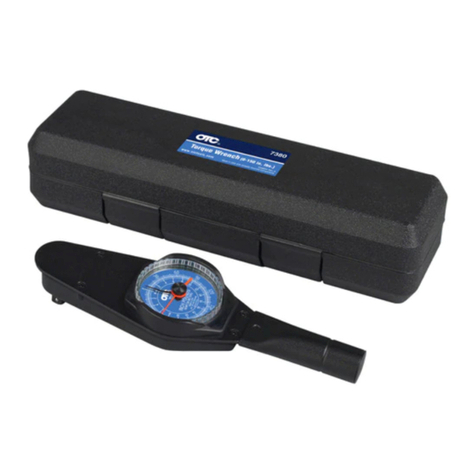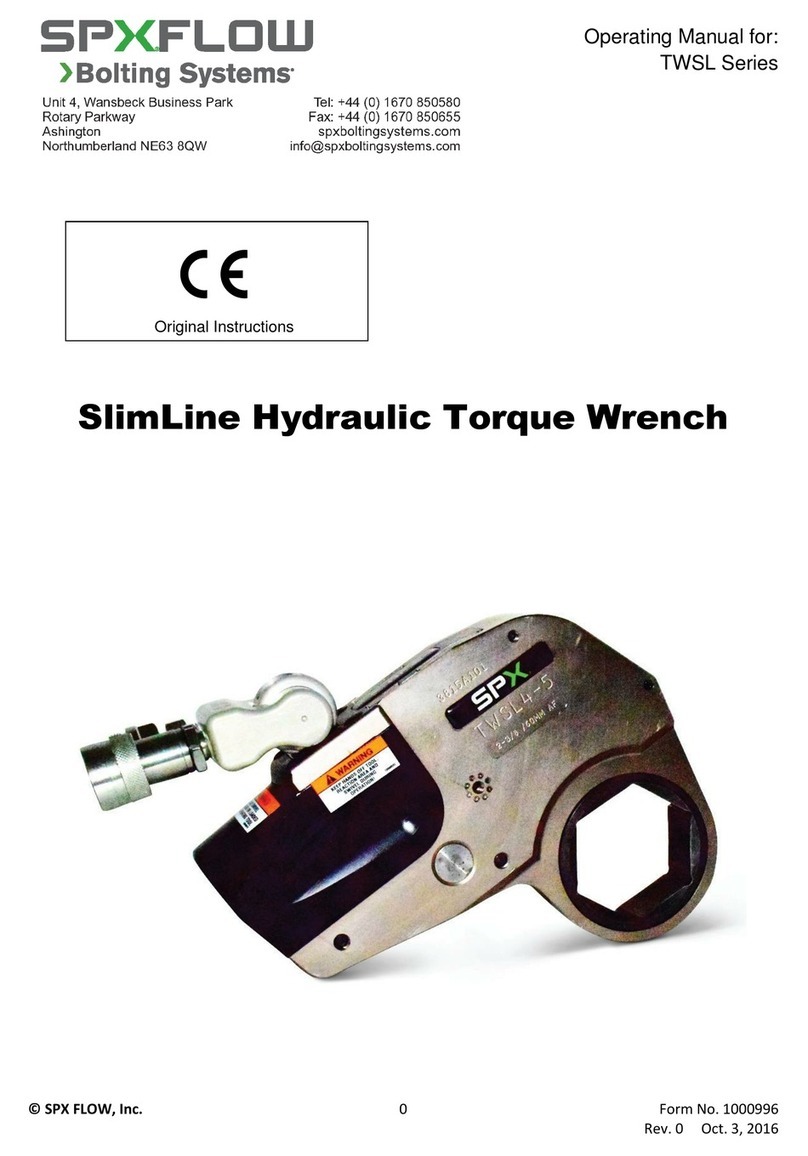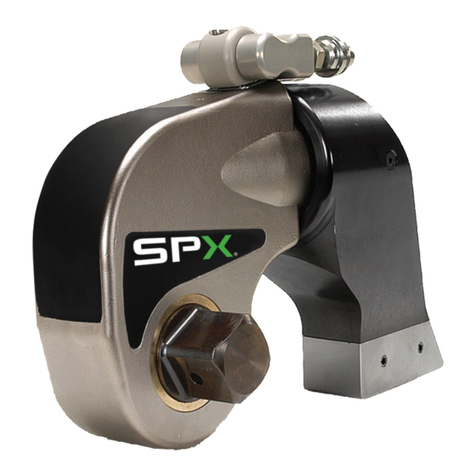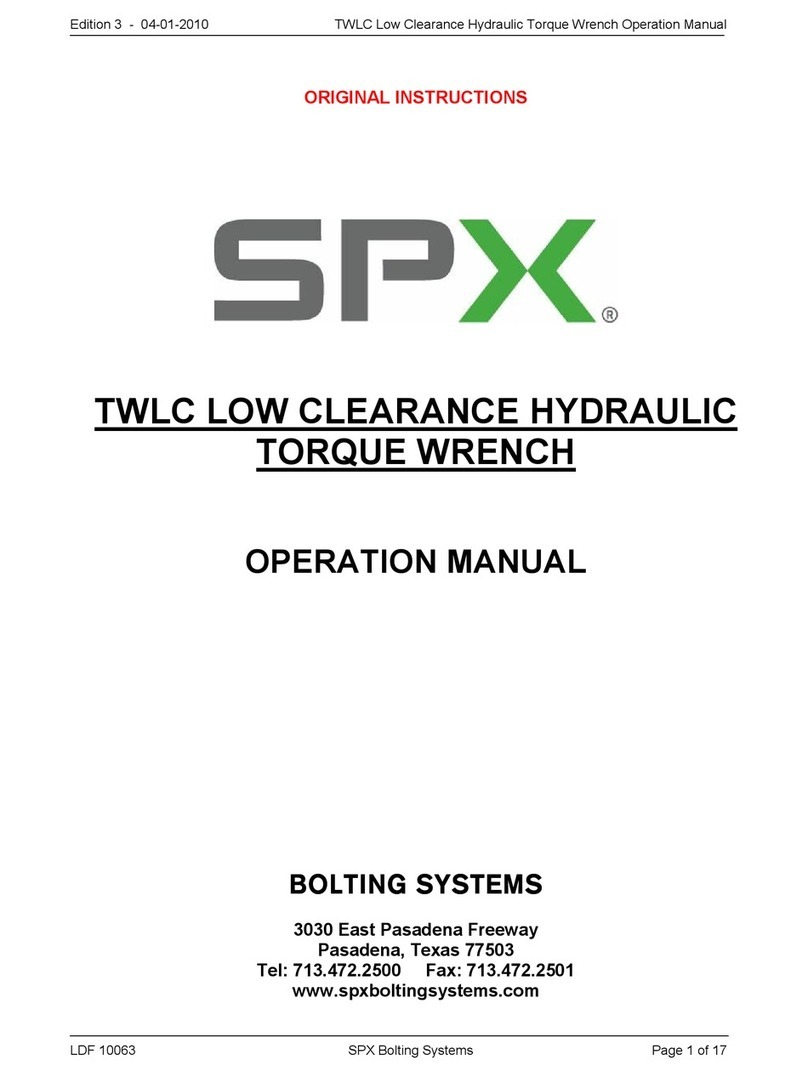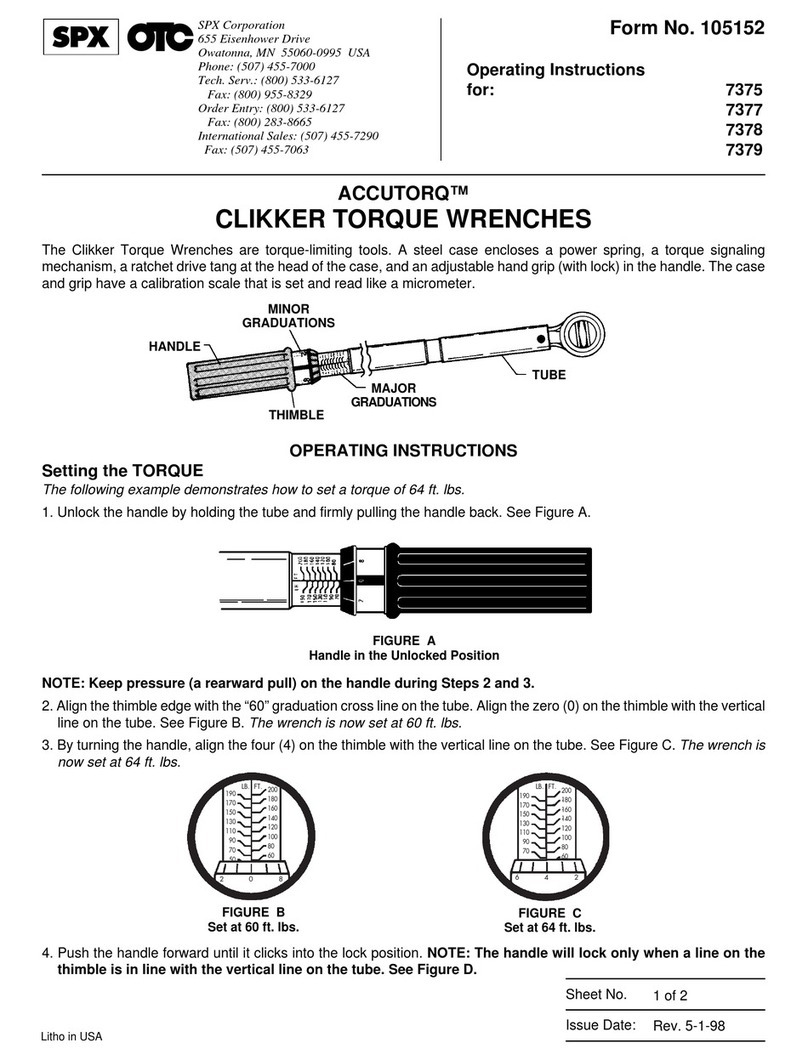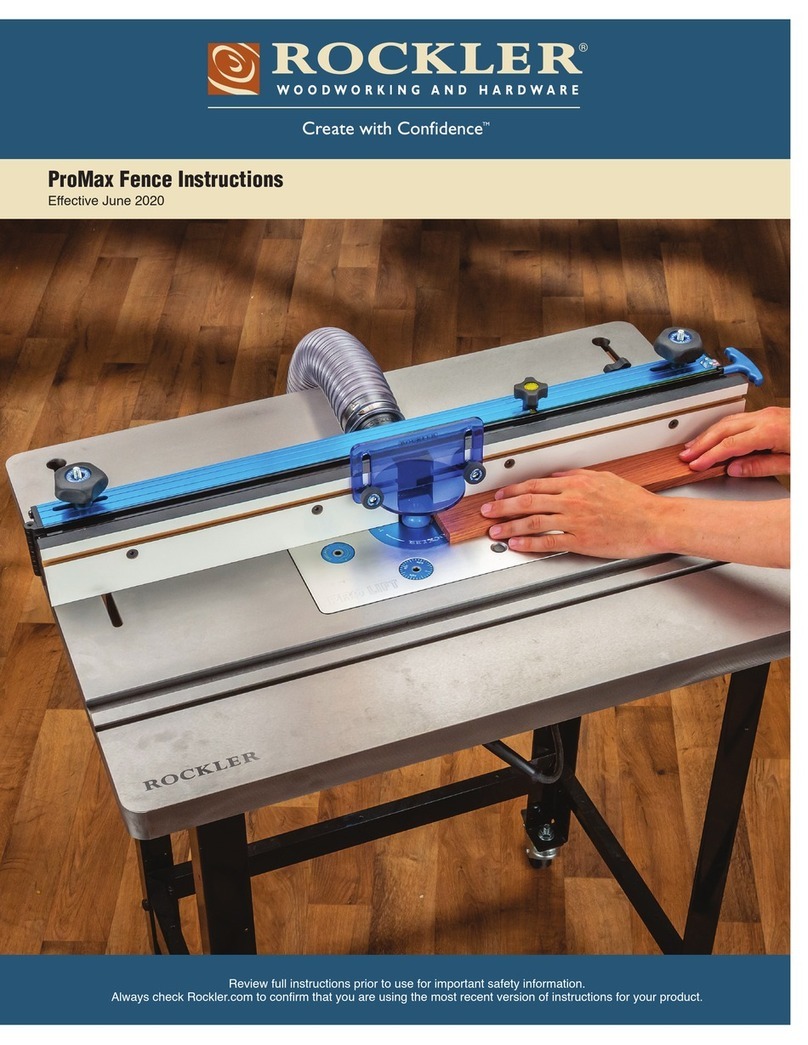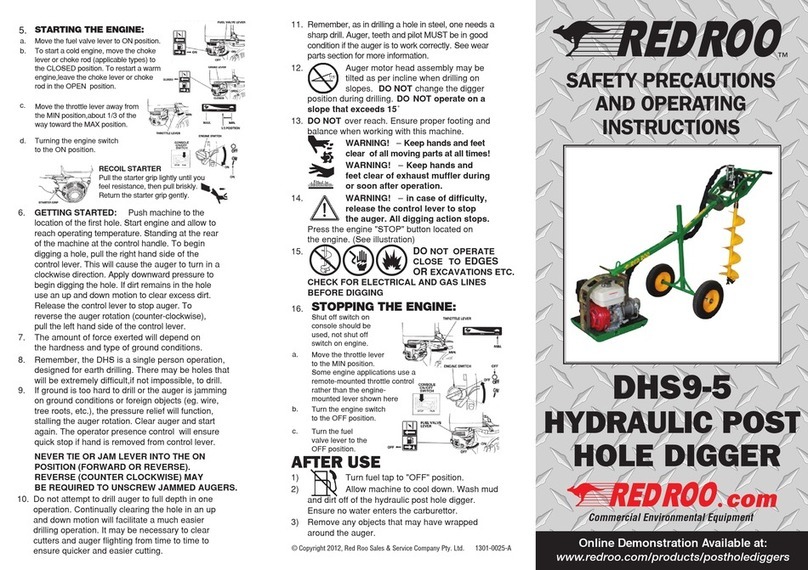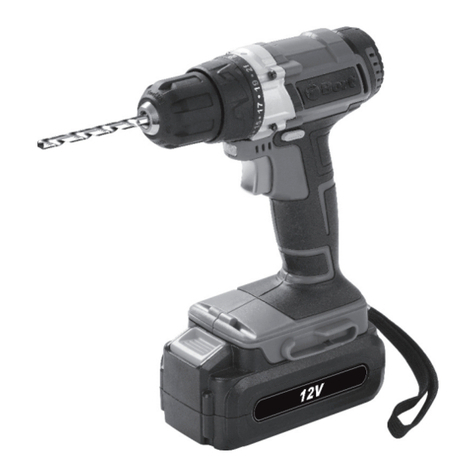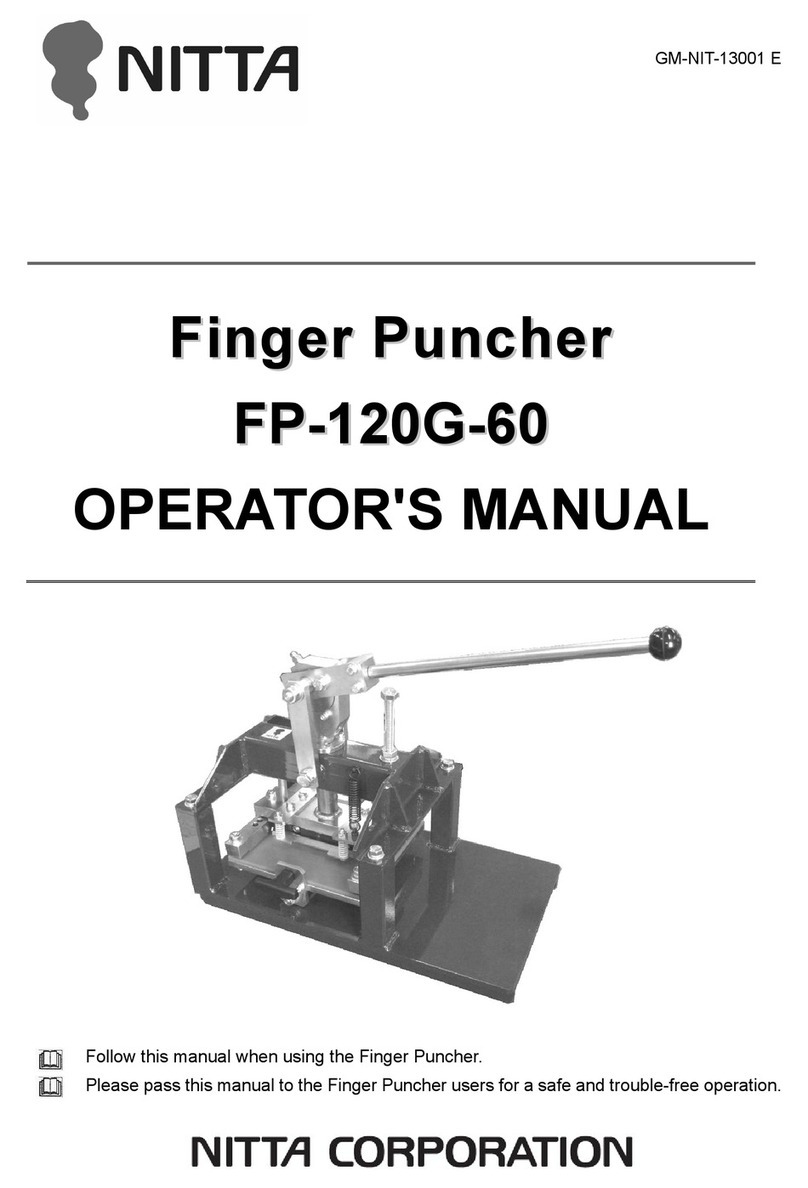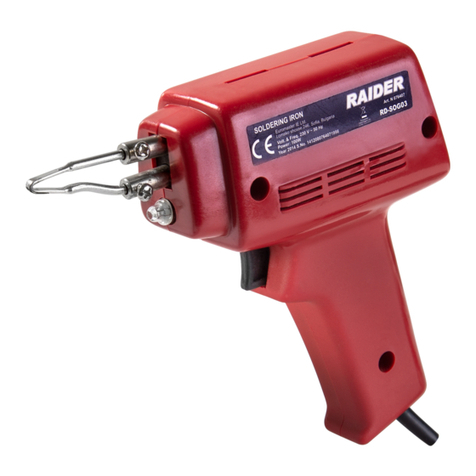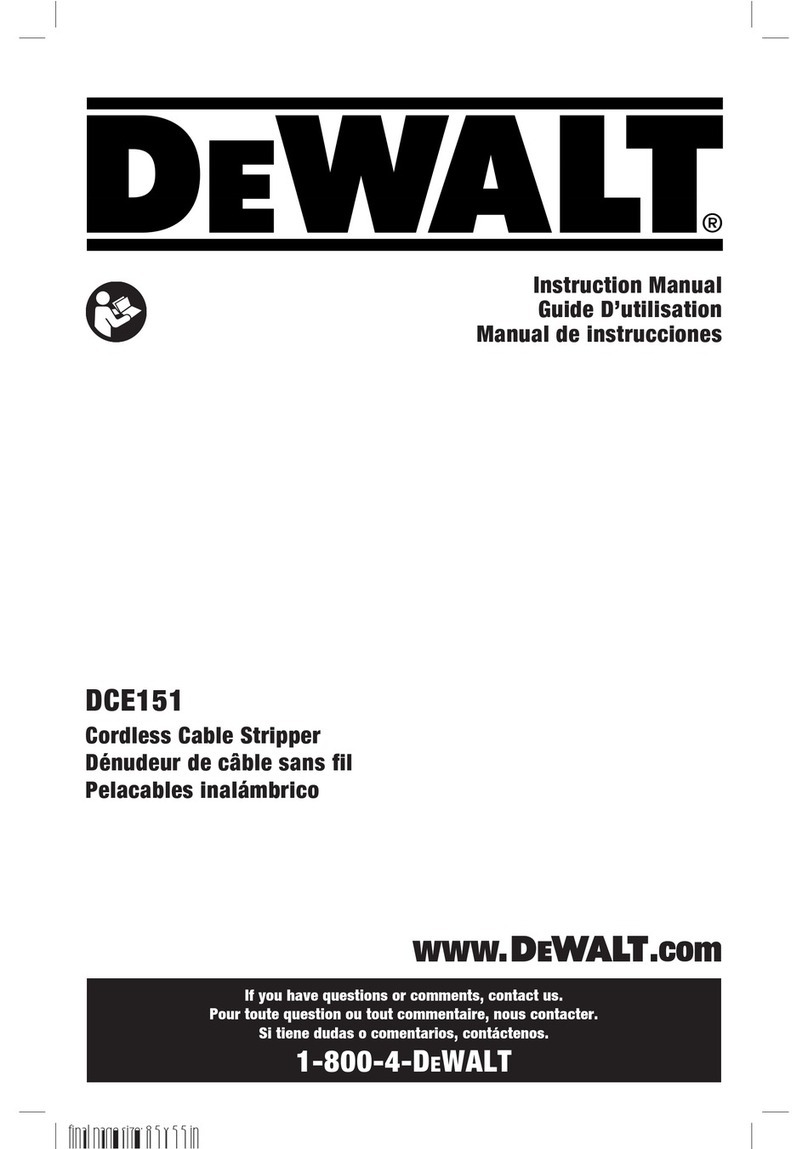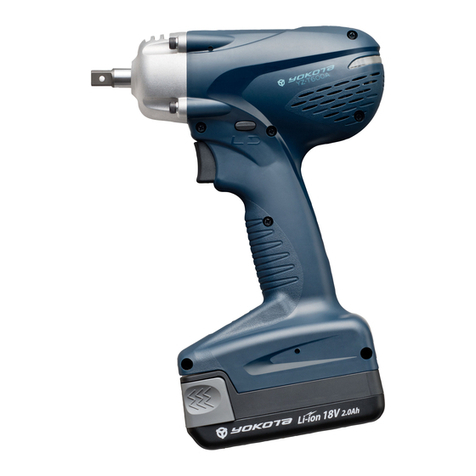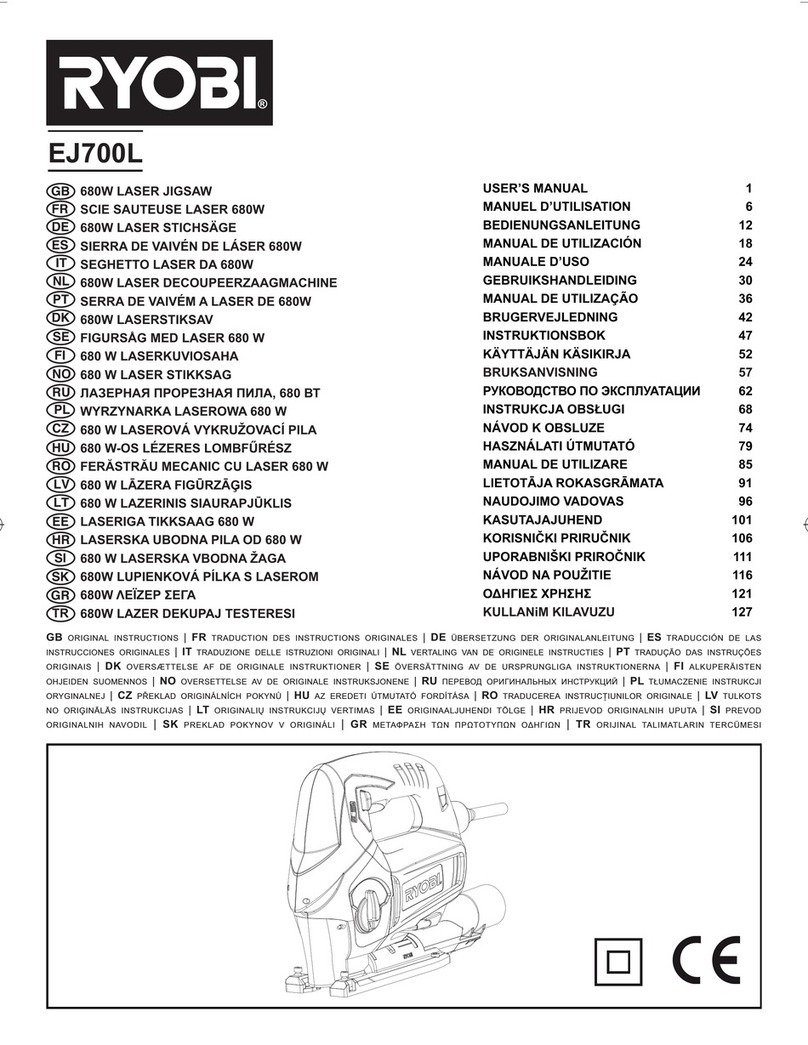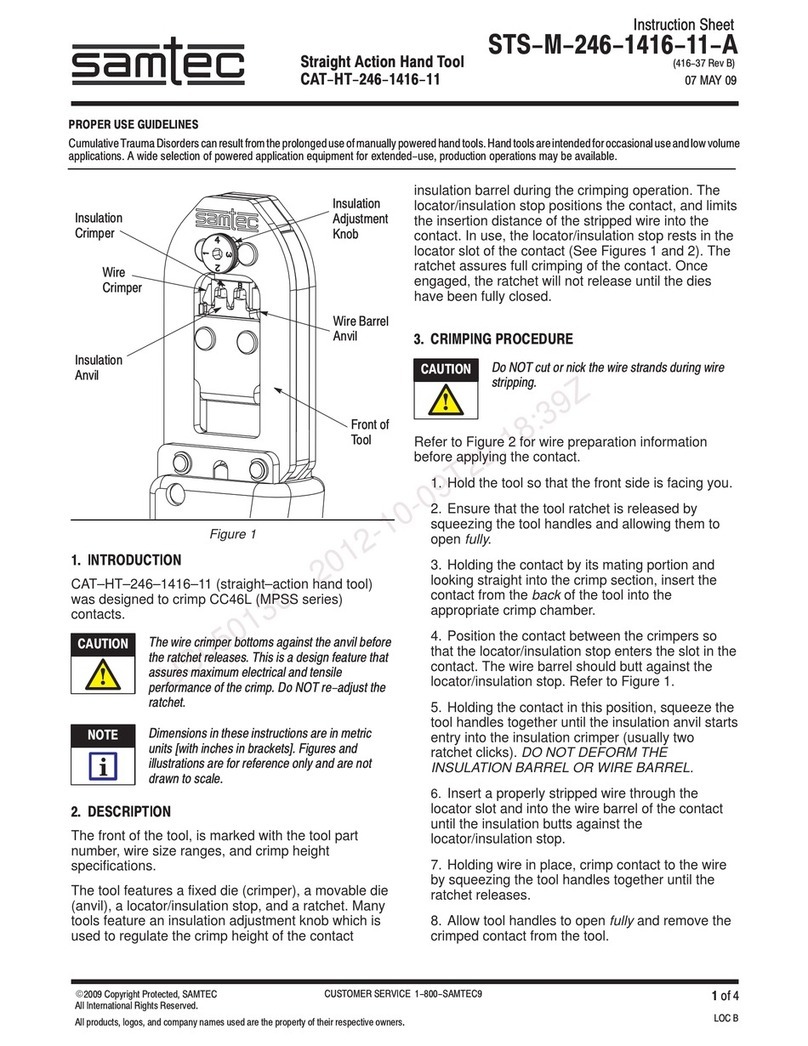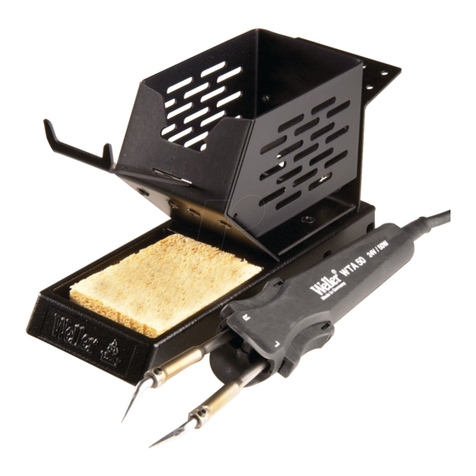SPX TWLC Series User manual

Operating Manual for:
TWLC Series
Low Clearance Hydraulic Torque
Wrench
Original Instructions
Unit 4, Wansbeck Business Park
Rotary Parkway
Ashington
Northumberland NE63 8QW
Tel: +44 (0) 1670 850580
Fax: +44 (0) 1670 850655
SPX Bolting Systems
© SPX Form No. 1000529
Rev. 1 December 6, 2011

1
© SPX Form No. 1000529
Rev. 1 December 6, 2011
Table of Contents
Torque Wrench Low Clearance (TWLC)................................................................................................... 2
Safety Symbols and Denitions................................................................................................................ 3
Safety Precautions ................................................................................................................................... 3
Pump ............................................................................................................................................ 3
Electric Motor................................................................................................................................ 4
Hoses............................................................................................................................................ 4
Initial Setup............................................................................................................................................... 6
Power Requirements .................................................................................................................... 6
Torque Wrench Usage .................................................................................................................. 7
Connecting the System................................................................................................................. 7
Hydraulic Connections.................................................................................................................. 7
Accessory Operation .................................................................................................................... 7
Safety............................................................................................................................................ 8
Preparing the Torque Wrench for Use .......................................................................................... 9
Setting Torque ........................................................................................................................................ 10
Operating Instructions ............................................................................................................................ 12
Positioning the Hydraulic Torque Wrench on the Nut ............................................................................. 12
Reaction Point Safety............................................................................................................................. 12
Use of Backing Wrenches ...................................................................................................................... 13
Torque Wrench Selection............................................................................................................ 13
Tightening Bolts .......................................................................................................................... 13
Tightening a Flanged Joint ......................................................................................................... 13
Loosening Bolts .......................................................................................................................... 14
Performance Specications.................................................................................................................... 16
Technical Specications.............................................................................................................. 16
Pressure/Torque Conversion Chart ........................................................................................................ 17
General Maintenance ............................................................................................................................. 18
Maintenance, Service, and Warranty.......................................................................................... 19
End of Life and Disposal............................................................................................................. 19
Troubleshooting...................................................................................................................................... 20
Repair Procedures.................................................................................................................................. 21
Torque Wrench Head Disassembly ............................................................................................ 21
Torque Wrench Head Assembly ................................................................................................. 22
Multiswivel Manifold Disassembly .............................................................................................. 23
Multiswivel Manifold Assembly ................................................................................................... 23
Hydraulic Cylinder/Body Disassembly........................................................................................ 24
Hydraulic Cylinder/Body Assembly ............................................................................................. 26
Parts Lists............................................................................................................................................... 27
TWLC2/4 Torque Wrench Parts List ........................................................................................... 27
TWLC2 Torque Wrench: Head Parts List.................................................................................... 30
TWL4 Torque Wrench: Head Parts List ...................................................................................... 33
TWL8/15/30 Torque Wrench Parts List....................................................................................... 40
TWL8 Torque Wrench: Head Parts List ...................................................................................... 43
TWL15 Torque Wrench: Head Parts List .................................................................................... 47
TWL30 Torque Wrench: Head Parts List .................................................................................... 52
EC Declaration of Conformity................................................................................................................. 58

2
© SPX Form No. 1000529
Rev. 1 December 6, 2011
Torque Wrench Low Clearance (TWLC)
Description: The TWLC is a hydraulic ratchet-type torque tool for tightening nuts and bolts. It uses
interchangeable drive heads to t a variety of sizes. Reducers are offered with the drive heads to
adapt to specic size nuts and bolts. It is powered with a 690 bar (10,000 psi) hydraulic pump unit;
the torque output from the TWLC torque wrench is proportional to the pump pressure applied.
QUICK-CHANGE HEAD
MULTISWIVEL MANIFOLD
HYDRAULIC
COUPLINGS
BODY
HEAD-RELEASE PIN
REACTION PAD
Figure 1. TWLC Hydraulic Torque Wrench

3
© SPX Form No. 1000529
Rev. 1 December 6, 2011
The safety signal word designates the degree or level of hazard seriousness.
DANGER: Indicates an imminently hazardous situation which, if not avoided, will result in death
or serious injury.
WARNING: Indicates a potentially hazardous situation which, if not avoided, could result in death
or serious injury.
CAUTION: Indicates a potentially hazardous situation which, if not avoided, may result in minor
or moderate injury.
CAUTION: Used without the safety alert symbol indicates a potentially hazardous situation which, if not
avoided, may result in property damage.
IMPORTANT: Important is used when action or lack of action can cause equipment failure, either
immediate or over a long period of time.
Safety Symbols and Denitions
WARNING: To prevent personal injury,
The following procedures must be performed by qualied, trained personnel who •
are familiar with this equipment. Operators must read and understand all safety
precautions and operating instructions included with the device. If the operator
cannot read these instructions, operating instructions and safety precautions must
be read and discussed in the operator's native language.
These products are designed for general use in normal environments. These •
products are not designed for use in special work environments such as: explosive,
ammable, or corrosive. Only the user can decide the suitability of this product in
these conditions or extreme environments. Power Team will supply information
necessary to help make these decisions. Consult your nearest Power Team facility.
Safety glasses must be worn at all time by the operator and anyone within sight of •
the unit. Additional personal protection equipment may include: face shield, goggles,
gloves, apron, hard hat, safety shoes, and hearing protection.
The owner of this tool must verify that safety-related decals are installed, maintained, •
and replaced if they become hard to read.
Shut• OFF the motor before opening any connections in the system.
Pump
WARNING: To prevent personal injury,
Do not exceed the hydraulic pressure rating noted on the pump nameplate or •
tamper with the internal high pressure relief valve. Creating pressure beyond rated
capacities can result in personal injury.
Retract the system before adding uid to prevent overlling the pump reservoir. An •
overll can cause personal injury due to excess reservoir pressure created when
cylinders are retracted.
Safety Precautions

4
© SPX Form No. 1000529
Rev. 1 December 6, 2011
Electric Motor
WARNING: To prevent personal injury,
Electrical work must be performed and tested by a qualied electrician per local •
directives and standards.
Disconnect the pump from the power supply and relieve pressure before removing •
the motor case cover or performing maintenance or repair.
Check the total amperage draw for the electrical circuit you will be using. • For
example: Do not connect a pump that may draw 25 amps to a 20 amp fused electrical
circuit.
Never use an ungrounded power supply with this unit.•
Changing the voltage is an involved and, if incorrectly performed, hazardous procedure. •
Consult the manufacturer for specic information before attempting rewiring.
Wire pump motors for counterclockwise rotation when viewed from the shaft end of •
the motor.
Do not attempt to increase the power line capacity by replacing a fuse with another •
fuse of higher value. Overheating the power line may result in re.
Exposing electric pumps to rain or water could result in an electrical hazard.•
Avoid conditions that can cause damage to the power cord, such as abrasion, •
crushing, sharp cutting edges, or corrosive environment. Damage to the power cord
can cause an electrical hazard.
Hoses
WARNING: To prevent personal injury,
Before operating the pump, tighten all hose connections using the correct tools. Do •
not overtighten. Connections should be only secure and leak-free. Overtightening
can cause premature thread failure or high pressure ttings to split at pressures
lower than their rated capacities.
Should a hydraulic hose rupture, burst, or need to be disconnected, immediately •
shut off the pump and shift the control valve twice to release pressure. Never
attempt to grasp a leaking hose under pressure with your hands. The force of
escaping hydraulic uid could cause serious injury.
Safety Precautions continued

5
© SPX Form No. 1000529
Rev. 1 December 6, 2011
Do not subject the hose to potential hazard, such as re, sharp surfaces, heavy •
impact, or extreme heat or cold. Do not allow the hose to kink, twist, curl, or bend
so tightly that the uid ow within the hose is blocked or reduced. Periodically
inspect the hose for wear, because any of these conditions can damage the hose and
possibly result in personal injury.
Do not use the hose to move attached equipment. Stress can damage the hose and •
possibly cause personal injury.
Hose material and coupler seals must be compatible with the hydraulic uid used. •
Hoses also must not come in contact with corrosive material such as creosote-
impregnated objects and some paints. Consult the manufacturer before painting a
hose. Never paint the couplers. Hose deterioration due to corrosive materials may
result in personal injury.
Safety Precautions continued

6
© SPX Form No. 1000529
Rev. 1 December 6, 2011
Initial Setup
Each hydraulic torque wrench is supplied completely assembled and ready for use. A hydraulic pump
is required to provide the speed and pressure that makes the hydraulic wrench system efcient and
accurate.
Read and understand all instructions before operating the hydraulic torque wrench. It is the1.
operators responsibility to read, understand, and follow all safety instructions.
Remove the hydraulic torque wrench from the shipping container and visually inspect all2.
components for any shipping damage. If any damage is found, notify the carrier immediately.
DO NOT USE TOOL.
Power Requirements
The TWLC hydraulic torque wrench requires a hydraulic pump unit, twin-line connecting hose, and
couplings to operate. All components must be capable of operating at the system maximum working
pressure of 690 bar (10,000 psi). Note that the system maximum working pressure is dynamic, not
static.
Pump unit specication varies between manufacturers; however, for correct torque wrench operation,
the pump unit must include the following:
Double Acting—Pump unit must be capable of double acting operation for advancing and retracting
the Torque Wrench.
Variable Pressure Output—For torque setting, the pump unit must be able to be easily adjusted by the
operator for different pressure outputs.
Retract Pressure—Sometimes termed 'idle' pressure, this is the pressure used for torque wrench
retraction and must be xed at approximately 103 bar (1,500 psi). This pressure must not be operator
adjustable.
Remote Handset Controls—The preferred conguration for the handset is such that, upon starting the
pump unit, the pump enters retract or idle mode (pressure xed at 103 bar (1,500 psi)). To advance the
torque wrench, the handset advance/pressure button or lever is pressed and held, upon release of the
button, retract mode is automatically entered. A separate button or lever is used to stop the pump.
Automatic Pressure Release—The pump must automatically release system pressure when switching
between advance and retract modes.
Pump Flow Rate—The speed at which the hydraulic torque wrench operates is proportional to the oil
ow rate. In general, 2-stage pump units are preferred for torque wrench use as this allows rapid nut
rotation under low loads, with fast wrench retraction. As a minimum, 250 cm³/min @ 7 bar (15 ci/min @
100 psi) to 20 cm³/min @ 690 bar (1.2 ci/min @ 10,000 psi) should be specied; however, for optimum
speed and performance, at least 360 cm³/min @ 7 bar (22 ci/min @ 100 psi) to 30 cm³/min @ 690 bar
((1.8 ci/min @ 10,000 psi) is recommended.
Pressure Gauge—Clarity is important for accurate torque setting; therefore, a pressure gauge of at
least 100-mm (4-in.) diameter should be tted.
Hydraulic Couplings—TWLC hydraulic torque wrenches are tted with CEJN 230 screw-to-connect
couplings (1/4-in. NPT) as standard. Verify any couplings that are used are compatible with these
couplings and rated to the same working pressure, e.g. Parker 3000 couplings.
SPX Bolting Systems will not be responsible for torque wrench damage, malfunction or operator injury
caused by the use of an incorrect pump unit; therefore, check the compatibility of your pump unit before
operating the hydraulic torque wrench.

7
© SPX Form No. 1000529
Rev. 1 December 6, 2011
Torque Wrench Usage
To verify reasonable life and performance from the torque wrench and system (pump and hoses), these
guidelines should be followed:
Under normal use, the torque wrench should be limited to 75–80% of its maximum achievable torque•
output.
Under breakout conditions, because the bolt can suddenly break free and result in shock loads,•
jumping/jolting, it is recommended to limit the wrench output torque to 60–70% of maximum
achievable torque output. It is also a good idea to have torque in reserve for the odd stubborn bolt/
nut.
Once a corroded bolt has broken free, do not use a torque wrench to wind the nut from the bolt. This•
can cause the nut to bind and lock onto the bolt and make it impossible to remove. It is preferred
that a nut runner or impact wrench be used to remove the nut following initial breakout by hydraulic
torque wrench.
Occasional use of the torque wrench at full pressure/torque is acceptable, but unnecessary•
continuous use at full pressure will reduce the life of the torque wrench and system.
In elevated temperature environments, it is advisable to cool the torque wrench as much as practical•
to maintain the sealing systems in good order. Depending upon the pressure applied to the wrench,
repeated use in temperatures in excess of 40°C will affect the life of the hydraulic seals.
If the temperatures are likely to exceed 40°C, it is advisable to use a larger capacity wrench so that
the pressure to achieve the required torque is reduced. This will result in less temperature buildup
and less softening of the seals.
Seals should be replaced regularly because, at elevated temperatures, the extrusion resistance of
the seal is reduced.
Connecting the System
The hydraulic wrench head and power pack are connected by a 690 bar (10,000 psi) twin-line hose
assembly. Refer to the power-unit manufacturer's operating instructions for proper use.
Hydraulic Connections
Never connect or disconnect any hydraulic hoses or fittings without first unloading the•
wrench and the pump.
Open all hydraulic controls several times to verify the system has been completely•
depressurized.
If the system includes a gauge, double check the gauge to verify pressure has been•
released.
When making connections with quick-disconnect coupling, verify the couplings are fully•
engaged. Threaded connections such as fittings, gauges, etc., must be securely tightened
and leak-free.
Accessory Operation
Links and reducers are available for each drive body. For more information, contact your SPX Bolting
Systems authorized service center.
Initial Setup continued

8
© SPX Form No. 1000529
Rev. 1 December 6, 2011
Safety
The TWLC hydraulic torque wrench is a high-power hydraulic tool. It is strongly recommended that all
users are fully trained and competent in the use of hydraulic torque wrench systems. Incorrect use of
the equipment or failure to follow any of the safety precaution included herein could lead to serious
injury.
Never exceed the hydraulic torque wrench maximum working pressure of: Advance 690 bar (10,000•
psi) and Retract 103 bar (1,500 psi).
Keep hands and fingers clear of the hydraulic torque wrench head and reaction pad area, before and•
during operation.
Keep other personnel clear of the working area and only allow trained personnel to use the•
equipment.
Before operation, verify all hoses and equipment is in proper working order. Verify all hydraulic•
torque wrench components (i.e. head, body, etc.) are properly attached and secure. Verify the head
release pin is properly located.
Do not strike any of the components, including the socket, to shock the nut free.•
Verify reaction structures are strong and rigid enough to accept the torque tool reaction forces. Do•
not use wedges, packing pieces, etc. as a temporary reaction.
If backing wrenches are used, keep hands and limbs well clear of the backing wrench.•
Take care when handling equipment. Quick connect couplings are especially susceptible to knocks•
and damage and therefore care must be taken. Note that damaged couplings are difficult to connect.
Do not force couplings.
Verify hoses are in good condition and undamaged. Do not bend hoses beyond their safe bend•
radius limit or kink the hose.
Do not strike, misuse or abuse any of the equipment. If any abuse or misuse of the equipment is•
evident, the warranty shall be invalid and the Manufacturer shall not be responsible for any injuries
or failures as a result.
In some instances, it may be necessary for the operator to support the hydraulic torque wrench while•
it is tightening, i.e. upside-down operations. If the hydraulic torque wrench cannot be strapped into
position using ropes, etc., the operator must take care to avoid pinch points.
If not in use, and when practical, disconnect the wrench and pump from the power supply to prevent•
accidental starting.
Do not tighten any equipment while under pressure. Do not move or rotate the multiswivel manifold•
while under pressure.
Verify that any inserts that are to be used with the hydraulic torque wrench are of impact quality and•
capable of withstanding the full torque output of the tool.
Some hydraulic torque wrenches weigh in excess of 20 Kg (40 lb). If necessary, lifting equipment•
can be used.
In some instances, it may be necessary for the operator to support the hydraulic torque wrench while•
it is tightening, i.e. upside-down operations. If the hydraulic torque wrench cannot be strapped into
position using ropes, etc., the operator must take care to avoid pinch points.
Never use the hydraulic torque wrench with just one hose connected to the Advance port (Port A).•
This will cause the pressure to intensify within the retract chamber possibly leading to tool damage.
Always verify that both hoses are correctly connected.
Initial Setup continued

9
© SPX Form No. 1000529
Rev. 1 December 6, 2011
Preparing the Torque Wrench for Use
IMPORTANT: For a copy of the calibration certificate for a specific hydraulic torque wrench,
e-mail [email protected] with serial number of the hydraulic torque wrench.
CAUTION: For top performance, frequently inspect wrench, pump, and accessories for visual
damage. Always follow instructions for proper wrench and pump maintenance. Do not use other
equipment to increase the capability (i.e., hammering on socket wrench).
Assembling/Removing the Drive Head
See Figure 2. Before the TWLC hydraulic torque wrench can be used, the correct drive head for the nut
must be tted to the TWLC body. No special tools are needed to change the drive head. If a drive head
is already assembled, it can be detached by pushing out the head retainer pin, and simply lifting out the
body. The drive assembly will auto-disengage.
NOTE: The hydraulic torque wrench must be fully retracted before the head can be
removed or attached.
WARNING: Disconnect from the hydraulic supply before attempting to change the
torque wrench head. Operating the wrench without the head attached exposes the
moving piston drive mechanism, and can result in trapped fingers or other injury.
Figure 2. Body and Drive Head Removal and Attachment
See Figure 2. To assemble a drive head, position the drive head onto the body, engaging the keyways
on the inner surface of the drive head sideplates with the keys on the body. Slide the drive head fully
onto the body and push the head retaining pin back into position.
Initial Setup continued
NOTE: The head retaining pin does
not detach from the body. It is held
captive within the sideplate.
DO NOT PUNCH OUT.
Retaining pin tension
adjustment screw

10
© SPX Form No. 1000529
Rev. 1 December 6, 2011
Figure 3. Head Retaining Pin
See Figure 3. Verify the pin is fully engaged. Damage to the body can occur if operated with a partially
engaged pin. Regularly check that the pin is fully engaged during operation because handling and
movements of the wrench can cause the pin to dislodge. The set screw is in place to keep the pin from
coming out completely. However, the pin can come out partially during use.
See Figure 2. If necessary, the retaining tension on the pin can be adjusted by turning the spring
plunger located in the wrench body.
Setting Torque
Verify the system is fully connected and the proper power supply is available.1.
Refer to the Pressure/Torque Conversion Chart in the Performance Specications section. Note that 2.
this pressure is set on the pump.
Turn on the pump.3.
Press and hold the remote control button.4.
Check the pressure on the gauge.5.
Increase or decrease pressure as required. Refer to pump manufacturer's operating instructions.6.
Before tightening a nut, press the remote control button and conrm the correct pressure has been 7.
set.
Verify that the bolt threads, nut threads, and nut-to-ange contact faces are liberally coated with anti-8.
seize lubricant of the same friction coefcient used to derive the torque value.
Make sure the hydraulic torque wrench is suitable to deliver the required torque. Should the torque9.
value exceed 80% of the hydraulic torque wrench output, consider using a higher capacity hydraulic
torque wrench.
NOTE: LDF torque wrenches are equipped with a pressure release valve built into the
multi-axis swivel manifold to protect against retract pressure intensification should the
retract port hydraulic coupling not be fully connected, or become loose during use. If
an intensification occurs, the valve will bleed hydraulic oil externally from the manifold
yoke. Oil bleeding from the swivel manifold is not a sign of seal leakage.
Initial Setup continued

11
© SPX Form No. 1000529
Rev. 1 December 6, 2011
Use the Pressure/Torque Conversion Chart in this manual to obtain the required pump pressure.10.
Verify that the drive head to be used is of the correct type and size. A poor tting or oversized drive 11.
head can damage nuts, induce inaccurate bolt loads, and may result in operator injury.
Before applying the hydraulic torque wrench to the application, the pump output pressure must be12.
preset to relieve at the pressure obtained from the Pressure/Torque Conversion Chart. This can be
done with the hydraulic torque wrench connected to the pump and resting on the oor or bench.
Applying advance pressure to the hydraulic torque wrench will extend the piston until it reaches the
end of its stroke whereby the pump pressure will build. Holding the wrench at the end of its stroke
will allow the pump pressure to be adjusted. Retract the hydraulic torque wrench piston and advance
again making sure that the pump relieves at the desired pressure setting. The pump pressure can
also be set by blanking the pump outlets using blank couplings.
NOTE: Allow time for the wrench to retract. If another advance stroke is made before
the torque wrench has fully retracted, the ratchet mechanism may not engage correctly,
causing it to jump a ratchet tooth, and possibly damaging the ratchet. Before applying
another advance stroke, make sure the pump is idling at 103 bar (1,500 psi), which
indicates full retraction.
Initial Setup continued

12
© SPX Form No. 1000529
Rev. 1 December 6, 2011
Operating Instructions
Positioning the Hydraulic Torque Wrench on the Nut
The TWLC hydraulic torque wrench ts directly around the nut, with its built-in reaction pad designed to
brace against an adjacent nut. Figure 4 indicates correct position of the hydraulic torque wrench (shown
in tightening mode). Always verify that the reaction pad braces rmly against an adjacent nut or secure
reaction structure.
Figure 4. Correct Positioning of the Hydraulic Torque Wrench
Reaction Point Safety
Follow these guidelines when selecting appropriate reaction points:
The reaction structure must be rigid enough to accommodate the forces from the hydraulic torque•
wrench. Carefully inspect the reaction points for suitability before applying the torque tool. If in doubt,
contact the torque wrench supplier for advice.
Tapered surfaces are generally unsuitable as the torque wrench tends to 'ride up' the taper, causing•
adverse tool loads. Flat surfaces are preferred.
Packing pieces, spacers, etc. must never be used as a makeshift reaction point. Reaction•
accessories are available to increase the access to reaction points.
Reaction pad is braced firmly
against an adjacent nut.

13
© SPX Form No. 1000529
Rev. 1 December 6, 2011
Use of Backing Wrenches
Backing wrenches are often used to prevent the non-tightening nut on the opposite side of the joint
assembly from turning during the torquing operation. Verify that the backing wrench is the correct
size and securely fastened in position (using straps, ropes, etc.). As the torquing operation begins, it
is normal for the backing wrench to move/rotate in conjunction with the torqued nut, until the backing
wrench contacts an adjacent reaction point. It is important that the operator stand clear of the moving
backing wrench to prevent accidental entrapment. The operator must also verify that the reaction point
is secure and sufciently rigid to prevent damage to the structure.
Torque Wrench Selection
To choose the correct capacity Torque Wrench for the application, the estimated break-out torque
should be considered, not the tightening torque. Loosening bolts usually requires a higher torque, and if
a wrench has been selected on tightening criteria only, it will seldom perform in a break-out situation.
Break-out Considerations
Nuts / Bolts which have been correctly lubricated at the make-up / tightening stage will require
approximately 1.5 x tightening torque to loosen following a period of service, PROVIDED THEY HAVE
NOT BEEN SUBJECTED TO HEAT.
Corroded / rusted bolts, and bolts without lubrication applied at make-up, will require approximately 2 x
tightening torque to loosen. PROVIDED THEY HAVE NOT BEEN SUBJECTED TO HEAT.
Nuts / bolts subjected to heat, seawater corrosion, chemical corrosion, can require 3 to 4 x tightening
torque.
Before selecting a torque wrench for the application, ensure that the above has been considered.
Tightening Bolts
Apply the hydraulic torque wrench to the nut to be tightened and verify that the reaction pad is braced1.
rmly and squarely against the selected reaction point.
Start the pump and advance the hydraulic torque wrench. As the wrench strokes forward, the reaction2.
pad will press against the reaction point and the socket will rotate. When the hydraulic torque wrench
reaches the end of its stroke, the pump pressure will build rapidly. Fully retract the hydraulic torque
wrench (the wrench ratchet mechanism will be heard clicking as it retracts), and apply another
forward stroke.
Several forward strokes are made until the nut ceases to rotate during the stroke (known as stalling),3.
but bear in mind that nut rotation will always cease at the end of the wrench stroke and must not be
confused with the wrench stalling. When the wrench stalls, apply another forward stroke and observe
the pump pressure gauge. The pump pressure gauge should read the desired preset pressure.
Retract the hydraulic torque wrench, stop the pump unit, and remove the wrench from the nut.4.
Tightening a Flanged Joint
This procedure outlines the basic steps to torque-tighten a anged joint with a TWLC hydraulic
torque wrench. It is important that personal protective equipment (gloves, footwear, safety helmet,
eye protection, etc.) is worn at all times by the operator and any other personnel in the work area.
The torquing procedure uses a single hydraulic torque wrench to accurately achieve a predetermined
residual bolt stress.
Operating Instructions continued

14
© SPX Form No. 1000529
Rev. 1 December 6, 2011
WARNING: Before bolt torquing, verify that:
The procedure and data to be used is authorized by a responsible engineer.•
The joints/pipework being worked on are not live. Joints must be at zero pressure and free •
from hazardous substances.
The torque value selected must be based upon the lubricant applied.•
Procedure
Working in a crisscross pattern, number each bolt in order of torque sequence.1.
Square up the anged joint using hydraulic torque wrenches, if necessary.2.
Set the pump at its lowest possible output, 103 bar (1,500 psi), and following the numbers on the3.
bolts, apply the minimum torque to the bolts.
In the same tightening sequence, apply approximately 25% of the torque value specied in the 4.
torque data.
In the same tightening sequence, apply approximately 50% of the torque value specied in the 5.
torque data.
In the same tightening sequence, apply the full torque value specied in the torque data.6.
Working in a clockwise (or counter-clockwise) direction, make a nal pass around the ange, 7.
tightening each bolt to the full torque value specied in the torque data.
Using a hammer, “ring” each nut to verify that each bolt has been correctly loaded and that no slack8.
bolts remain.
Loosening Bolts
Loosening bolts using hydraulic torque wrenches can be unpredictable and often unsuccessful,
especially if the nuts and bolts are severely corroded. However, some measures can be carried out to
increase the success rate of nut breakout:
In general, loosening mildly rusted bolts requires up to twice the makeup torque to release the nut.•
Heavily corroded bolts may take up to three times the makeup torque. Verify that the bolt and nut
material is strong enough to accept these higher torques.
Remove surface rust and scale using a wire brush. Apply releasing oil to the nut, bolt, and bearing•
face, and allow time for the release oil to soak in and penetrate.
Only use the hydraulic torque wrench to break the nut free. Using the torque tool to wind the nut•
from the bolt can induce high torsion and reaction forces. Therefore, it is better to use an impact
wrench to completely remove the nut.
Never strike the torque wrench or nut/bolt in an attempt to 'shock' the nut free. This can cause•
damage to the hydraulic torque wrench and operator injury. Evidence of torque wrench abuse will
void the Manufacturer's Warranty.
NOTE: Should maximum pump pressure be reached, and the nut has not broken free,
use a higher capacity hydraulic torque wrench (if the nut/bolt material will accept the
higher torques without damage). Do not, under any circumstances, strike the hydraulic
torque wrench or nut/bolt in an attempt to 'shock' the nut free.
Operating Instructions continued

15
© SPX Form No. 1000529
Rev. 1 December 6, 2011
Procedure
Connect the hydraulic torque wrench to the pump unit. Verify that the couplings are fully screwed1.
together; they are self-sealing and will restrict oil ow if not fully connected.
Before applying the hydraulic torque wrench to the application, the pump output pressure must be2.
preset to deliver the maximum pressure of 690 bar (10,000 psi). This can be done with the torque
wrench connected to the pump and resting on the oor or bench. Applying advance pressure to the
hydraulic torque wrench will extend the piston until it reached the end of its stroke whereby the pump
pressure will build. Holding the wrench at the end of its stroke will allow the pump pressure to be
adjusted. Retract the hydraulic torque wrench piston and advance again making sure that the pump
delivered full pressure. The pump pressure can also be set by blanking the pump outlets using blank
couplings.
Apply the hydraulic torque wrench to the nut to be loosened and verify that the reaction pad is braced3.
rmly and squarely against the selected reaction point.
Start the pump and advance the hydraulic torque wrench. As the wrench strokes forward, the reaction4.
pad will press against the reaction point. As the pump pressure builds (and torque is applied to the
nut), the nut will break free. Once the nut has been released, remove the nut by hand if loose enough,
or alternatively use an impact wrench. Using the hydraulic torque wrench is not recommended.
NOTE: Should maximum pump pressure be reached, and the nut has not broken free,
use a higher capacity hydraulic torque wrench (if the nut/bolt material will accept the
higher torques without damage). Do not, under any circumstances, strike the hydraulic
torque wrench or nut/bolt in an attempt to 'shock' the nut free.
Retract the hydraulic torque wrench, stop the pump unit, and remove the wrench from the nut.5.
Operating Instructions continued

16
© SPX Form No. 1000529
Rev. 1 December 6, 2011
Performance Specications
Technical Specications
The following technical data is applicable to all TWLC hydraulic torque wrenches:
MAXIMUM PRESSURE: Advance - 690 bar (10,000 psi)
Retract - 103 bar (1,500 psi)
OPERATING TEMPERATURE LIMITS: -20°C to +40°C (-4°F to 104°F)
HYDRAULIC OIL TYPE: Grade 46 hydraulic oil
Wrench Ref Head Size range, mm
(in.)
Torque Output, ft-lb Approximate
Weight, kg (lb)
MIN** MAX
TWL2 32–60 (1 1/4–2 3/8) 189 1,575 3.5 (7.7)
TWL4 40–80 (1 1/2–3 1/8) 477 3,975 7.0 (15.4)
TWL8 60–100 (2 1/4–3 7/8) 954 7,950 11.0 (24.3)
TWL15 65–120 (2 9/16–4 5/8) 1,782 14,850 19.0 (41.9)
TWL30 80–155 (3 1/8–6 1/8) 3,456 28,800 38.0 (83.8)
** Note that minimum torque can be lower depending upon pump low-pressure capability

17
© SPX Form No. 1000529
Rev. 1 December 6, 2011
Pressure/Torque Conversion Chart

18
© SPX Form No. 1000529
Rev. 1 December 6, 2011
General Maintenance
Maintenance
Maintenance should follow each period of use to keep the TWLC hydraulic torque wrench in good
working condition.
TWLC Hydraulic Torque Wrench
Wipe away any debris that may have accumulated, particularly around the swivel manifold and1.
hydraulic couplings.
See Figure 5. Remove the drive head from the body. Inspect the following components:2.
Hydraulic couplings for signs of damage.•
Shuttle pins to verify they are present and spring freely.•
Head/body pin retainer to verify it is undamaged and operates correctly.•
Swivel manifold to verify the retaining ring is present and tted correctly.•
See Figure 5. Lubricate the areas of the body using Revol R5 Moly Anti Seize. The drive head should3.
be reassembled onto the body for storage to prevent dirt from getting into the drive mechanism.
NOTE: The TWLC torque wrench drive components must be lubricated using the
specified product only. Using alternative lubricants will affect the torque wrench and
might lead to premature component failure.
Lightly spray the hydraulic torque wrench with water-repellent spray before placing in storage.4.
Figure 5. TWLC Hydraulic Torque Wrench Maintenance
Hoses
Clean and inspect each hydraulic hose and quick-connect coupling. Check the entire length of1.
the hose for cuts, abrasions, and damage. Replace the entire hose if any evidence of damage is
present.
Coat each quick-connect coupling with a water repellent spray.2.

19
© SPX Form No. 1000529
Rev. 1 December 6, 2011
Maintenance, Service, and Warranty
In addition to post-use maintenance, and to ensure that the Product Warranty remains valid, it is
recommended that routine maintenance and servicing be carried out by the Manufacturer or Authorized
Service Centre.
Maintenance and servicing should be carried out in accordance with the manufacturer's ‘Equipment
Maintenance and Servicing Manual’.
All LDF Torque wrenches are supplied under the Manufacturers’ standard terms and conditions.
All components shall be guaranteed for a period of twelve months from the date of purchase against
material defects and workmanship. All components shall be guaranteed for a period of twelve months
from the date of purchase against defects arising from normal use, with the following exclusions:
Hydraulic seals and back-up rings•
Bushes and bearings•
O-ring seals•
Quick-disconnect couplings•
Labels and decals•
Springs•
Circlips•
Paints and coatings•
Plastic screws and plugs•
End of Life and Disposal
In accordance with our End of Life Policy, should the product be no longer required for use, it should be
returned to TTS Ltd where it shall be disposed of in a safe and environmentally friendly manner.
General Maintenance continued
This manual suits for next models
5
Table of contents
Other SPX Power Tools manuals
